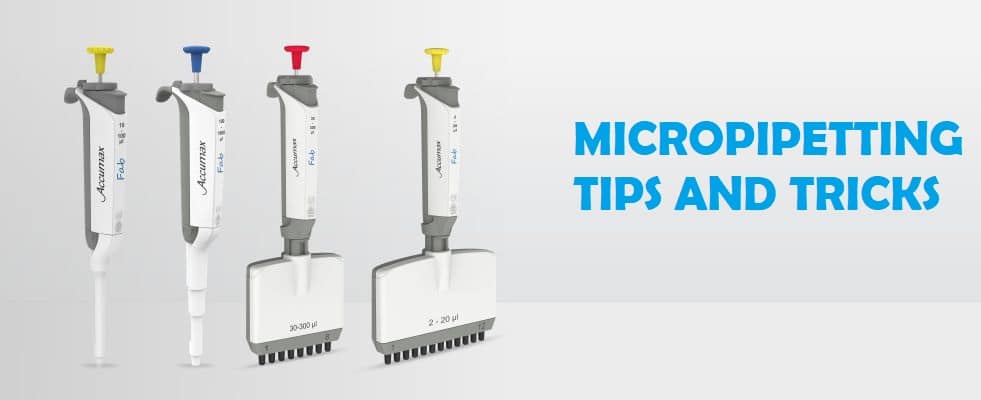Micro-pipetting Tips And Tricks

What is a Micropipette?
A micropipette is a laboratory tool used to dispense small and precise volumes of liquid in the range of microliters (µL) to milliliters (mL). It consists of a plunger, a priston, and a tip that can be easily attached and removed. Micropipettes are commonly used in various applications, such as molecular biology, biochemistry, analytical chemistry, and medical diagnostics. They are essential for many laboratory procedures that require accuracy, precision, and reproducibility.
What is Micropipetting?
Micropipetting is a fundamental technique used in many laboratories for accurate and precise transfer of small volumes of liquids. However, it can be challenging for new users to master.
Accumax is one of the fastest growing liquid handling equipment globally. It delivers quality pipettes – Fab Pipette, Accumax – Smart, Accumax A Series, Accumax PRO, Accumax VA-FA, Electronic Pipette, Junior Pipette, and Transfer Pipette.
Choose the right tip size
Choosing the right tip size is critical to accurate pipetting. The volume you are transferring should fall within the pipette’s volume range, and the tip should fit securely on the end of the pipette. Be sure to use tips that are designed for your specific pipette.
Pre-wet your tip
Before aspirating your sample, it is a good idea to pre-wet the tip. This helps to prevent air bubbles from forming, which can affect the accuracy of your pipetting. To pre-wet your tip, pipette a small amount of your sample into the tip and then dispense it back to the sample. Repeat this process a few times to ensure that the tip is thoroughly wetted.
Use a consistent technique
Using a consistent technique when pipetting can help to improve accuracy and precision. Hold the pipette at a 45 degree angle, and immerse the tip into the liquid. Slowly depress the plunger to the first stop to aspirate the liquid. Release the plunger slowly and smoothly to dispense the liquid. Avoid jerky movements, as this can cause air bubbles to form.
Check the calibration of your pipette
It is essential to regularly check the calibration of your pipette to ensure that it is dispensing the correct volume. Many pipettes have a calibration tool that can be used to verify accuracy. If you notice that your pipette is consistently dispensing incorrect volumes, it may be time to have it serviced or replaced.
Minimize sample loss
To minimize sample loss when pipetting, be sure to aspirate and dispense slowly. Additionally, be sure to touch the tip to the side of the receiving vessel when dispensing the liquid to ensure that all the liquid is transferred.
Avoid contamination
Contamination can be a significant problem when pipetting. To avoid contamination, always use a new tip for each sample. Additionally, be sure to change tips between different reagents to prevent cross-contamination.
Clean your pipette regularly
Regular cleaning of your pipette can help to extend its lifespan and ensure accurate pipetting. Be sure to follow the manufacturer’s cleaning recommendations, and avoid using harsh chemicals that can damage the pipette.
What is a displacement pipette?
A displacement pipette, also known as a positive displacement pipette, is a type of micropipette that uses a disposable piston to displace the liquid being pipetted. Unlike air displacement pipettes, which use air to create a vacuum for aspirating and dispensing liquids, displacement pipettes use a positive displacement mechanism.
The disposable piston is made of a soft, flexible material such as polypropylene or silicone, and is designed to fit snugly inside the pipette barrel. When the piston is pushed into the pipette barrel, it creates a vacuum that draws the liquid up into the pipette tip. When the piston is pulled back, it pushes the liquid out of the tip.
Original Source: https://thebillionairepost.com/micro-pipetting-tips-and-tricks/

